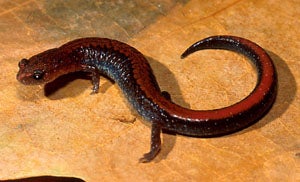SCIENTIFIC NAME:
Plethodon serratus
STATUS:
Poorly known. Documented from a few localities in upper Ridge and Valley near Anniston. May occur in adjacent Talladega Uplands of the Piedmont. Easily confused with southern zigzag and Webster's salamanders. HIGH CONSERVATION CONCERN.
DESCRIPTION:
This is a small salamander seldom exceeding 4”. The sides are dark gray to black with a red dorsal stripe. The belly is mottled with light and dark pigments. Costal grooves number 20-21 in most individuals. It is easily confused with southern zigzag and Webster’s salamanders.
DISTRIBUTION:
Occurs along Appalachian Mountains from North Carolina south to Calhoun County, Alabama. It has been documented in several localities in the upper Ridge and Valley physiographic region near Anniston. It may occur in adjacent uplands of the Piedmont.
HABITAT:
They inhabit forests and woodlands where they seek refuge under forest litter, rocks, and logs. They are most active above ground in late winter and early spring.
FEEDING HABITS:
Redback salamanders forage along the forest floor in search of small insects.
LIFE HISTORY AND ECOLOGY:
Typical nesting occurs in the summer inside log cavities or stumps. Eggs usually number eight to ten and are laid in a cluster attached to the rook of the cavity by a pedicel. The female attends the nest until hatching. There is no aquatic larval stage in this species.
REFERENCES:
Conant, Roger. 1975. A Field Guide to Reptiles and Amphibians of Eastern and Central North America. Houghton Mifflin Co., Boston, MA. 442-443 pp.
Mount, Robert H. 1996. The Reptiles & Amphibians of Alabama. The University of Alabama Press. Tuscaloosa, AL. 144-145 pp.
AUTHOR: Matt Brock, Wildlife Biologist, Division of Wildlife and Freshwater Fisheries






